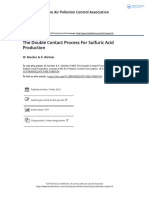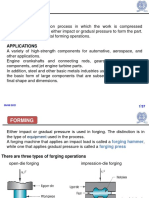0 ratings0% found this document useful (0 votes)
473 viewsContact Process: Manufacture of Sulphuric Acid
Contact Process: Manufacture of Sulphuric Acid
Uploaded by
fatahleeSulphuric acid is manufactured through the contact process, which involves 3 main stages:
1) Sulphur is burned in air or heated sulphides to produce sulphur dioxide.
2) Sulphur dioxide is oxidized to sulphur trioxide over a vanadium pentoxide catalyst at high temperatures.
3) Sulphur trioxide is absorbed in concentrated sulphuric acid to form oleum, which is then diluted with water to produce concentrated sulphuric acid.
Copyright:
Attribution Non-Commercial (BY-NC)
Available Formats
Download as DOCX, PDF, TXT or read online from Scribd
Contact Process: Manufacture of Sulphuric Acid
Contact Process: Manufacture of Sulphuric Acid
Uploaded by
fatahlee0 ratings0% found this document useful (0 votes)
473 views3 pagesSulphuric acid is manufactured through the contact process, which involves 3 main stages:
1) Sulphur is burned in air or heated sulphides to produce sulphur dioxide.
2) Sulphur dioxide is oxidized to sulphur trioxide over a vanadium pentoxide catalyst at high temperatures.
3) Sulphur trioxide is absorbed in concentrated sulphuric acid to form oleum, which is then diluted with water to produce concentrated sulphuric acid.
Original Title
Contact Process
Copyright
© Attribution Non-Commercial (BY-NC)
Available Formats
DOCX, PDF, TXT or read online from Scribd
Share this document
Did you find this document useful?
Is this content inappropriate?
Sulphuric acid is manufactured through the contact process, which involves 3 main stages:
1) Sulphur is burned in air or heated sulphides to produce sulphur dioxide.
2) Sulphur dioxide is oxidized to sulphur trioxide over a vanadium pentoxide catalyst at high temperatures.
3) Sulphur trioxide is absorbed in concentrated sulphuric acid to form oleum, which is then diluted with water to produce concentrated sulphuric acid.
Copyright:
Attribution Non-Commercial (BY-NC)
Available Formats
Download as DOCX, PDF, TXT or read online from Scribd
Download as docx, pdf, or txt
0 ratings0% found this document useful (0 votes)
473 views3 pagesContact Process: Manufacture of Sulphuric Acid
Contact Process: Manufacture of Sulphuric Acid
Uploaded by
fatahleeSulphuric acid is manufactured through the contact process, which involves 3 main stages:
1) Sulphur is burned in air or heated sulphides to produce sulphur dioxide.
2) Sulphur dioxide is oxidized to sulphur trioxide over a vanadium pentoxide catalyst at high temperatures.
3) Sulphur trioxide is absorbed in concentrated sulphuric acid to form oleum, which is then diluted with water to produce concentrated sulphuric acid.
Copyright:
Attribution Non-Commercial (BY-NC)
Available Formats
Download as DOCX, PDF, TXT or read online from Scribd
Download as docx, pdf, or txt
You are on page 1of 3
Manufacture of Sulphuric
Acid
o Sulphuric acid is made from sulphur dioxide, through the
Contact Process.
o The raw materials used to manufacture the acid are sulphur,
air and water.
o There are three stages for the production of sulphuric acid by
the contact process.
i. The production of sulphur dioxide
ii. Formation of sulphur trioxide
Contact Process
Stage 1:The production of sulphur dioxide
This can be obtained through two methods.
a) Heating liquid sulphur with hot air in a furnace.
S(s) + O2(g) → SO2 (g)
b) Heating sulphides in air, for example:
4FeS2 (s) + 11O2 (g) → 2Fe2O3 (s) +8SO2 (g)
SO2 is a side product in the extraction of the metal, iron. [Fe 2O3 is reduced to iron with
coke].Zinc pyrites can also be heated in air as follows:
2ZnO (s) + 3O2 (g) → 2SO2 (g) + 2ZnO (s)
Stage 2: Formation of sulphur trioxide
a) Pure, dry sulphur dioxide is mixed with dry oxygen in excess and passed over vanadium (V)
oxide, V2O5 as catalyst at a temperature of 450oC - 550oC and a pressure of 1 atmosphere. So
by Le Chatelier's Principle, higher temperatures will force the equilibrium position to shift
to the left hand side of the equation favouring the production of sulfur dioxide.
Lower temperatures would favour the production of the product sulfur trioxide and result in a
higher yield. The conditions ensure the maximum production of sulphur trioxide:
2SO2 (g) + O2 (g) ⇋ 2SO3
(g)
b) The reaction takes place in a heat converter.
c) Excess air is used to ensure a higher percentage of SO3 produced.
Stage 3: Production of sulphuric acid
a) Sulphur trioxide is passed through an absorption tower when it is absorbed by concentrated
sulphuric acid to form a viscous liquid called olleum, H2S2O7.
SO3 (g) + H2SO4 (l) → H2S2O7 (l)
b) Oleum is diluted with water to obtain the required concentration of the acid, because
oleum does not show any property of an acid. Equal volumes of water and oleum will give
98% concentration of sulphuric acid:
H2S2O7 (l) + H2O (l) → 2H2SO4 (l)
*Oleum is also called fuming sulphuric acid.
c) Water is not used to absorb SO3 as the reaction is extremely exothermic. The heat produced
forms very fine mist on the acid which does not condense easily. The mist is corrosive and
pollutes the air,that why this reaction is not carried out in industry. It is too vigorous.
The flow chart of Contact Process:
Sulphur (Burnt in air) Sulphur dioxide SO2 Sulphur trioxide SO3
→ *Further oxidation → Dissolves in
*Catalyst: V2O5 concentrated sulphuric
*Temperature: (450 -500) oC acid, H2SO4
*Pressure:1 atmosphere (by Le
Chatelier's Principle )
↓
Concentrated of ← Oleum H2S2O7
sulphuric acid, H2SO4 Dilute with water
You might also like
- Claudel 1986Document15 pagesClaudel 1986majesty9No ratings yet
- Nowak 1966Document9 pagesNowak 1966adedwi utamaNo ratings yet
- Methanol PresentationDocument29 pagesMethanol Presentationافكر اشتري كورياNo ratings yet
- Chbi502 Chapter 2Document24 pagesChbi502 Chapter 2Chau MaiNo ratings yet
- Process Flow Diagram Ethylene OxideDocument2 pagesProcess Flow Diagram Ethylene Oxideheri100% (1)
- Ullmanns Enclopedia ChemistryDocument36 pagesUllmanns Enclopedia ChemistryLutfiNo ratings yet
- IntroductionDocument10 pagesIntroductionAmith Singh J100% (1)
- The Urea Manufacturing ProcessDocument5 pagesThe Urea Manufacturing ProcessJhonny Huanca ChampiriNo ratings yet
- The Double Contact Process For Sulfuric Acid ProductionDocument3 pagesThe Double Contact Process For Sulfuric Acid Productionshahira anuarNo ratings yet
- The Industrial Manufacture of Sulphuric Acid (H SO) : Contact ProcessDocument7 pagesThe Industrial Manufacture of Sulphuric Acid (H SO) : Contact Processprinc123No ratings yet
- Industrial Preparation of Sulphuric AcidDocument20 pagesIndustrial Preparation of Sulphuric Acidvishnu_c_singhNo ratings yet
- Advancements in Sulfur Recovery ProcessesDocument21 pagesAdvancements in Sulfur Recovery Processesprateek kumarNo ratings yet
- Production of Hydrogen Gas From Refinery Off-Gas StreamDocument75 pagesProduction of Hydrogen Gas From Refinery Off-Gas Streamيزيد العزانيNo ratings yet
- Sample ABCDocument128 pagesSample ABCNaviinthiran Arasu100% (1)
- Report Compiled 1Document14 pagesReport Compiled 1Opeyemi KehindeNo ratings yet
- Unit 1Document24 pagesUnit 1yashrajNo ratings yet
- Sulfuric Acid (H SO) IndustryDocument27 pagesSulfuric Acid (H SO) IndustryAqsa chNo ratings yet
- Cost Estimation HNO3Document4 pagesCost Estimation HNO3yogeshdama100% (1)
- Hall Heroult Process and Hooper ProcessDocument9 pagesHall Heroult Process and Hooper ProcesssaadNo ratings yet
- Ammonia (Rev 3) 266 - 27591Document4 pagesAmmonia (Rev 3) 266 - 27591dyah ayuNo ratings yet
- Ammonia Stripping MethodDocument2 pagesAmmonia Stripping MethodsagbvnNo ratings yet
- Ammonia and Urea Production.Document10 pagesAmmonia and Urea Production.180190105084rabadiyahenilNo ratings yet
- ConclusionDocument2 pagesConclusionfrhslmn100% (1)
- CPT - Lecture - 22 and 23 - Sulphuric Acid ProcessDocument29 pagesCPT - Lecture - 22 and 23 - Sulphuric Acid ProcesssaisounyaNo ratings yet
- R.V. College of Engineering, Bangalore-560059 (Autonomous Institution Affiliated To VTU, Belgaum)Document10 pagesR.V. College of Engineering, Bangalore-560059 (Autonomous Institution Affiliated To VTU, Belgaum)Paridhi GargNo ratings yet
- Msds Molten SulphurDocument9 pagesMsds Molten SulphurLily DianaNo ratings yet
- Haber ProcessDocument6 pagesHaber ProcessLuis Daniel Gil PachecoNo ratings yet
- A Term Paper Report OnDocument42 pagesA Term Paper Report OnmohanrtamNo ratings yet
- Manufacture Nitric AcidDocument9 pagesManufacture Nitric AcidDjayustinus Heri HermawanNo ratings yet
- Unit - II Process in Organic Chemical manufacture-II HydrogenationDocument15 pagesUnit - II Process in Organic Chemical manufacture-II HydrogenationMaahir AppNo ratings yet
- Chemistry - Formulas and EquationsDocument25 pagesChemistry - Formulas and Equationssgw67No ratings yet
- Production of Sulfuric AcidDocument26 pagesProduction of Sulfuric AcidAkpan Anthonia AthanasiusNo ratings yet
- Oxosynthesis, Udex and Fischer Tropsch SynthesisDocument21 pagesOxosynthesis, Udex and Fischer Tropsch SynthesisNisha SubashNo ratings yet
- Proposal 2Document7 pagesProposal 2Engr. Asif malikNo ratings yet
- Ammonium SulfateDocument3 pagesAmmonium SulfateXiwen Huang100% (1)
- Safety: Table 1: Safe Equipment. Authors: Cango. P, Espinoza. A, Lopez. C. (2019)Document4 pagesSafety: Table 1: Safe Equipment. Authors: Cango. P, Espinoza. A, Lopez. C. (2019)Alexander EspinozaNo ratings yet
- Kgs KGS: Gujarat Alkalies and Chemicals LimitedDocument1 pageKgs KGS: Gujarat Alkalies and Chemicals LimitedChetan Solanki100% (1)
- A-Managing Hazardous Reactions and Compounds in Process Chemistry-American Chemical Society (2014)Document466 pagesA-Managing Hazardous Reactions and Compounds in Process Chemistry-American Chemical Society (2014)DanielNo ratings yet
- Carbon Dioxide Absorption Into Promoted Carbonate SolutionsDocument10 pagesCarbon Dioxide Absorption Into Promoted Carbonate SolutionsDunyu LiuNo ratings yet
- Hazop Study: 11.1.1 BackgroundDocument14 pagesHazop Study: 11.1.1 BackgroundMuhammad100% (1)
- Chapter Two Feasibility Study 2.0 Methods of Producing Ammonium Sulphate, ( (NH) SO)Document9 pagesChapter Two Feasibility Study 2.0 Methods of Producing Ammonium Sulphate, ( (NH) SO)Adeyoju RebeccaNo ratings yet
- Thesis On CatalystDocument36 pagesThesis On CatalystMahfuzur Rahman SiddikyNo ratings yet
- HE3 Semi-Batch Reactor TextDocument5 pagesHE3 Semi-Batch Reactor TextMiranda Hasanah ArrasyidNo ratings yet
- Petroleum (1) .PPT (Recovered)Document33 pagesPetroleum (1) .PPT (Recovered)Abdallah MansourNo ratings yet
- Kinetics of Acid-Catalyzed Cleavage of Cumene Hydroperoxide: M.E. Levin, N.O. Gonzales, L.W. Zimmerman, J. YangDocument19 pagesKinetics of Acid-Catalyzed Cleavage of Cumene Hydroperoxide: M.E. Levin, N.O. Gonzales, L.W. Zimmerman, J. YangMaria PaulaNo ratings yet
- Urea ModelingDocument20 pagesUrea ModelingekmagisNo ratings yet
- CH3-CH-OH CoohDocument105 pagesCH3-CH-OH CoohAniket GawdeNo ratings yet
- HF Alkylation and NExOCTANE Tech For Gasoline ProductionDocument42 pagesHF Alkylation and NExOCTANE Tech For Gasoline ProductionUsama Shakil0% (1)
- Oxychlorination Reactor DesignDocument45 pagesOxychlorination Reactor Designhinman714No ratings yet
- Membranes For Upgrading Biogas To Natural Gas Quality: Project Report February 2012Document20 pagesMembranes For Upgrading Biogas To Natural Gas Quality: Project Report February 2012Benjamin Angel Flores ZavalaNo ratings yet
- Thesis Syed AbbasDocument263 pagesThesis Syed AbbasabubakarNo ratings yet
- 2009 12 Brouwer UreaKnowHow - Com Phase Diagrams of The Urea ProcessDocument11 pages2009 12 Brouwer UreaKnowHow - Com Phase Diagrams of The Urea ProcessjunaidNo ratings yet
- Organometallic Transition Metal Catalysis: A Holistic Approach to Understanding and Predicting their MechanismsFrom EverandOrganometallic Transition Metal Catalysis: A Holistic Approach to Understanding and Predicting their MechanismsNo ratings yet
- Multiphase Reactor Engineering for Clean and Low-Carbon Energy ApplicationsFrom EverandMultiphase Reactor Engineering for Clean and Low-Carbon Energy ApplicationsYi ChengNo ratings yet
- Uses of Sulphuric Acid: SulphurDocument6 pagesUses of Sulphuric Acid: SulphurHumphrey JinuinNo ratings yet
- 1.11 CHEM FINAL Chapter 11 Sulfuric AcidDocument21 pages1.11 CHEM FINAL Chapter 11 Sulfuric AcidSudhanshuNo ratings yet
- Group 01Document34 pagesGroup 01Muhammad MugheeraNo ratings yet
- Folio ChemistryDocument1 pageFolio ChemistryCayep CullenNo ratings yet
- Manufacturing of Sulfuric Acid by Lead Chamber Process and Contact ProcessDocument14 pagesManufacturing of Sulfuric Acid by Lead Chamber Process and Contact ProcessDian Eka FajriyantoNo ratings yet
- Plug Flow ReactorDocument28 pagesPlug Flow ReactorNurul AinNo ratings yet
- Copper Pressure Piping SystemsDocument2 pagesCopper Pressure Piping SystemsstarykltNo ratings yet
- About REACH - PDFDocument4 pagesAbout REACH - PDFTri-Sure More Than ClosuresNo ratings yet
- Do 66 Pen Type Dissolved Oxygen Tester Meter For Aquarium Fish Tank AquacultureDocument3 pagesDo 66 Pen Type Dissolved Oxygen Tester Meter For Aquarium Fish Tank AquacultureJuan José Bonilla ReinosoNo ratings yet
- Rocket BasicsDocument37 pagesRocket BasicsNirmal Ramachandran100% (1)
- Thermodynamic Quantities For Selected Substances AT: AppendixDocument3 pagesThermodynamic Quantities For Selected Substances AT: AppendixSudibyo GunawanNo ratings yet
- 4K3B (SBP18) Suhu & Isipadu (Hukum Charles)Document4 pages4K3B (SBP18) Suhu & Isipadu (Hukum Charles)Syakir FahmieNo ratings yet
- Industry Brochure NLBE enDocument24 pagesIndustry Brochure NLBE enaditNo ratings yet
- ForgingDocument37 pagesForgingRafiqueNo ratings yet
- A. Rate Law and Mechanism of The S 2 ReactionDocument14 pagesA. Rate Law and Mechanism of The S 2 ReactionHimanshu RanjanNo ratings yet
- CV761 03 Rigid-PavementDocument85 pagesCV761 03 Rigid-PavementRama Raju Gottumukkala100% (1)
- Dipolar Coupling: RDCS, Structure, Dynamics and Disorder! Embo Course 2013!Document59 pagesDipolar Coupling: RDCS, Structure, Dynamics and Disorder! Embo Course 2013!Rigel_TNo ratings yet
- JurnalDocument16 pagesJurnalAlfyan PujiastuNo ratings yet
- DNA Fingerprinting: (Notes)Document10 pagesDNA Fingerprinting: (Notes)Nelson LaishramNo ratings yet
- Quizz de Cultivos ContinuosDocument12 pagesQuizz de Cultivos ContinuosRuben MarquezNo ratings yet
- Introduction To Positive Material Identification or PMI With PDFDocument3 pagesIntroduction To Positive Material Identification or PMI With PDFkamala 123No ratings yet
- Petroleum & Gas ExplorationDocument31 pagesPetroleum & Gas ExplorationNajeebUllahNo ratings yet
- Notes 9Document22 pagesNotes 9Ruben ChirinosNo ratings yet
- ANSULDocument4 pagesANSULMohan Varkey100% (1)
- Wrought Dental Alloys and Dental WireDocument14 pagesWrought Dental Alloys and Dental WireJu Ju WareeratNo ratings yet
- ASTM D6522-00 Determination of NOx, CO, and O2 Concentrations in Emissions Using Portable AnalyzersDocument9 pagesASTM D6522-00 Determination of NOx, CO, and O2 Concentrations in Emissions Using Portable AnalyzersFredi Cari Carrera100% (1)
- Separating Mixtures Exam QuestionsDocument35 pagesSeparating Mixtures Exam QuestionsMichael WestNo ratings yet
- MSDS AlkazymeDocument9 pagesMSDS AlkazymeEntje Achmad RikoNo ratings yet
- Chemical Pumps BrochureDocument4 pagesChemical Pumps BrochurepablopinNo ratings yet
- Material Safety Data Sheet: 2,2,4 - Trimethyl-1,3 - Pentanediol DiisobutyrateDocument4 pagesMaterial Safety Data Sheet: 2,2,4 - Trimethyl-1,3 - Pentanediol Diisobutyratealfa twoNo ratings yet
- Ge Elec 1 Module 2 Lesson 3 AssignmentDocument3 pagesGe Elec 1 Module 2 Lesson 3 AssignmentRucci LucianoNo ratings yet
- Food SpoilageDocument42 pagesFood Spoilagedrgunavet100% (7)
- Evaluation of Benefit of Solar Reflective Paint in Hot Climate V4Document15 pagesEvaluation of Benefit of Solar Reflective Paint in Hot Climate V4Asim ArainNo ratings yet
- Radioactive RaysDocument11 pagesRadioactive RaysMita NurhayatiNo ratings yet
- Chemical Cleaning, Decontamination and Corrosion H. S. Gadiyar, Chintamani Das and K. B. Gaonkar Metallurgy DivisionDocument24 pagesChemical Cleaning, Decontamination and Corrosion H. S. Gadiyar, Chintamani Das and K. B. Gaonkar Metallurgy DivisionHayder HusseinNo ratings yet

























































































